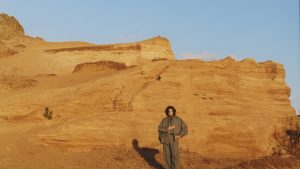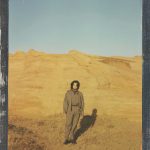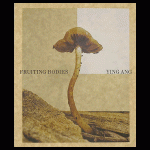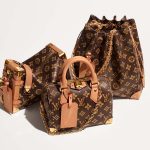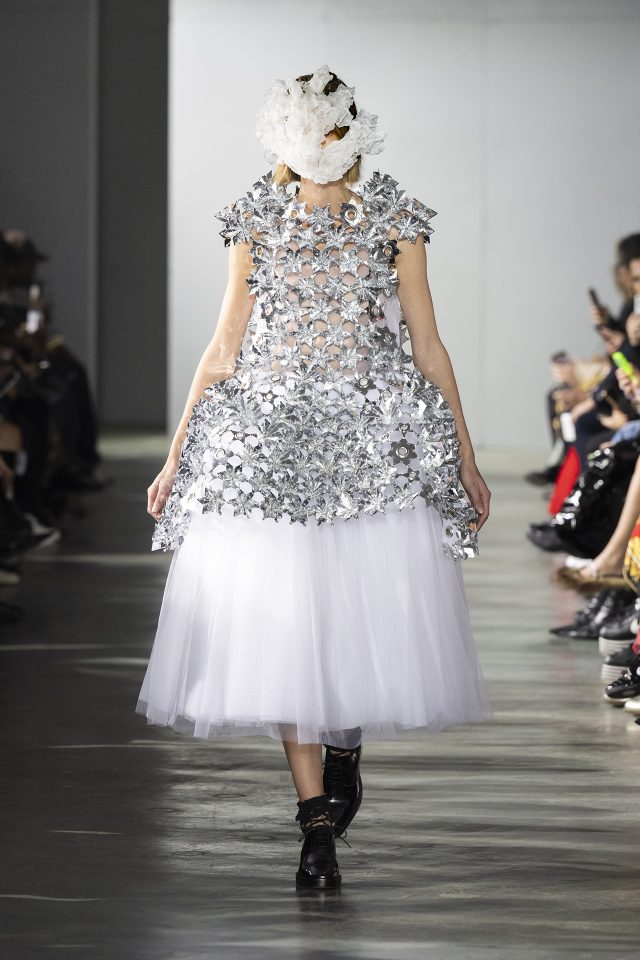人気IT系ライター三橋ゆか里インタビュー
News
人気IT系ライター三橋ゆか里インタビュー
Interview With Yukari Mitsuhashi
いま海外で注目されているファッション系のウェブサービスを知りたければこの人の記事を見ることをオススメする。ニュースサイトや雑誌にひっぱりだこの人気IT系ライター三橋ゆか里氏である。2008年からスタートした自身が運営するブログ『TechDoll(テック・ドール)』では国内外の有益な情報を発信し、多くの読者を抱えている。また2010年にはDavid Fincher (デヴィッド・フィンチャー) 監督の映画『The Social Network (ソーシャル・ネットワーク)』で字幕・吹き替え監修も担当した。そんな彼女に、いまオススメのファッション系ウェブサービス・アプリを紹介してもらった。
いま海外で注目されているファッション系のウェブサービスを知りたければこの人の記事を見ることをオススメする。ニュースサイトや雑誌にひっぱりだこの人気IT系ライター三橋ゆか里氏である。2008年からスタートした自身が運営するブログ『TechDoll(テック・ドール)』では国内外の有益な情報を発信し、多くの読者を抱えている。また2010年にはDavid Fincher (デヴィッド・フィンチャー) 監督の映画『The Social Network (ソーシャル・ネットワーク)』で字幕・吹き替え監修も担当した。そんな彼女に、いまオススメのファッション系ウェブサービス・アプリを紹介してもらった。
*この取材は2012年6月頭に行われたものです
—まずはじめに、三橋さんのバックグラウンドについて教えてください。
eコマースを運営する会社でプロジェクトマネージャーやマーケティングを行い、その後UI(ユーザーインターフェイス)やユーザビリティのコンサルティング会社でメディア事業の立ち上げに携わりました。いまはフリーランスになって2年半が経ちます。最初翻訳などの仕事から始まりましたが、ずっと書く仕事がしたかった。ひょんなことからネットで記事を書くようになり、記名式だったため名前を知ってもらえるようになり『日経デジタル・マーケティング』や『Hanako』などの紙媒体でも書くように。いまは、ライターや編集の仕事、またサービス立ち上げのコンサルティングなどをしています。
—『TechDoll(テック・ドール)』のコンセプトを教えてください。
ブログはフリーになった頃に立ち上げて、自分のアンテナに引っかかった海外のサービスやスマホアプリ、マーケティング事例などを紹介しています。ここ半年くらいは女性向けのサービス紹介にも力を入れています。仕事柄、新しいサービスやモノを取材したり、それをつくっている方に会うことが多い。そういうサービスを本当に使ってほしいのはIT業界の外の人たちです。でもどうしても、業界の中で花火みたいに盛り上がって一瞬で散ってしまうことが多い。ファッションとか可愛さとか、女性がすんなり入れるような切り口でブログを書くことで、より幅広い層にITを身近に感じてもらいたいという思いがあります。ブログタイトルは、女性が発信者であるということがわかるように「Tech」という言葉に「Doll」を組み合わせました。
—最近人気のあるウェブサービスを教えてください。
最近流行っているサービスに『Fab.com(ファブ・ドットコム)』があります。「生活にデザインを」というテーマで、洗練されたデザインアイテムを数量限定で販売。最初はインテリアや小物を扱っていましたが、ファッションカテゴリーの人気が高まったためファッション系サービスを買収してそこを強化しています。また、買える期間も決まっているため「いま買わなきゃ!」という気持ちにしてくれる。
次は『Shoedazzle(シューダズル)』。これはLA発、毎月ひとつのアイテムが送られてくる定期購入サービス。もともとシューズからはじまって、バックやアクセサリーなども扱うように。サービスに登録する際、ハリウッド女優の写真から普段のファッションスタイルに近いものを選んだり、普段履いているヒールに近い写真を選んだりする仕組みがあります。それをもとに、毎月「今月のあなたへのおすすめはこのアイテム」というユーザごとにカスタマイズされたショールームがメールで届くんです。中から一番好きなものだけを選ぶと、39.95ドル(約3,100円)で届けてくれるというサービス。
ネットの買い物の仕方は、ピンポイントで欲しいものが決まっている人にはすごく探しやすいんですけど、まだ決まっていない人がウィンドウショッピングをする感覚はまだ出せてない。Shoedazzleは、そんな部分を助ける提案形の買い物を実現してくれます。アイテムはLAのスタイリストが選んでくれる、というのもサービスの売りですね。残念ながら日本への発送には対応してません。
『Stylesaint(スタイルセイント)』は最近のヒット。みんな子どもの頃、雑誌の好きなページを破いてノートに貼ったりコラージュしていたと思うんですけど、その感覚をウェブで実現しているサービスです。最終的には独自のアパレルブランドを立ち上げるという野望を持って立ち上げたサービスらしく。そのためにも、スクラップしたモノからおしゃれ好きの人がどんなモノを好むのかを抽出して、それをデザインに反映していく。
「破る」というボタンを押すと、まるで雑誌を破ったみたいにビリビリとした見せ方が素敵。紙の体験をうまく再現してくれていて。自分のスクラップブックにタイトルを付けて、ウェブマガジンにできるんです。自分の好きなモノをただ一覧にするとか、ブックマークしていくサービスはありましたが、自分がウェブマガジンの編集者になった気分にさせてくれる。
『Pinterest(ピンタレスト)』は、20代から40代くらいの主婦がけっこう使っていて、子どもの誕生日会のテーマをどうしよう?とか、カップケーキのデザインをどうしよう?といった、デイリーで身近なインスピレーションやアイディアを得る場所。それに対して『Stylesaint』は憧れとか手の届かないモノ。まだユーザーがそんなに多くないですが、ファッションブロガーなどもけっこう使っているみたい。プチ有名人に直接アプローチして使ってもらったり、おしゃれな箱を押さえてイベントを開催して有名ブロガーを招待したりしてサービスを広めてます。『TechCrunch(テッククランチ)』のコンペティションにも出ていて、そこでも評価が高かったそうです。
人気なファッション系サービスをジャンルでまとめてみると、『GILT(ギルト)』のような共同購入系、『Shoedazzle』みたいな定期購入系、『Pinterest』を含むキュレーション系、だれが選んだかというのに価値がある。『Fab.com』もeコマースですが、いろいろな要素が混ざっています。定期購入、eコマース、キュレーションを掛け合わせてるというか。
— いま注目されているウェブサービスは画像系のサービスが多いですけど、これからテキストの扱いはどうなっていくと思いますか?
テキストに頼らないで伝えることが求められていくと思います。いわゆるデジタル・ネイティブ世代の人たちは、NAVERのようなまとめサイトを読むことすら苦痛だって聞きます。インターネット環境は速いし、1人1台スマホを持つようになって、誰もがプチカメラマン。もどかしい言葉を使わなくても写真で伝えられる。
『FAST COMPANY(ファスト・カンパニー)』というデザイン系のサイトがあります。サイトのデザインが画像メインのつくりになっていて、下にスクロールしていくと次々に記事が出てきてページングがない。画像で記事を選ぶ、みたいな感覚ですが、今後こういうサイトは増えていくと思います。
また、ウェブサイトの「テキストを取っ払う」サービスを作った人がいて。『Wordless Web(ワードレス・ウェブ)』というんですが、どんなサイトでも『Wordless Web』のブックマークレットをクリックするとテキストが一切消えてしまう。これを使うと、いかに自分のサイトがテキストに依存しているかがわかる。
インフォグラフィック人気も、テキストではなく視覚的に伝えることが重要視されていく流れのひとつ。パッと見てわかりやすいことが大事。データをインフォグラフィクスにして表現するだけでより多くの人が見てくれたりバズったりするので活用するサイトや企業が増えていますね。
—情報が溢れているなかで、有益な情報をどうやって見つけていますか。
RSSとかも使ってますが、どちらかというと見るサイトが決まっている感じです。ブログをやっているとある程度更新しなきゃいけないので、普段からネタ探しをする習慣ができているので。昔はけっこうSNSでランダムに流れてきた情報を見ていましたが、最近は自分が特に興味があるアカウントをTwitterのリスト機能で見ています。「みんなが“シェア”してるから“シェア”する」という人もけっこういるので、関心事が同じ人を見つけて「その人がセレクトした情報だから見る」ようになりました。
またiPhone/iPadアプリの『Flipboard(フリップボード)』や『Zite(ズィート)』というサービスも使います。読んだ記事や“Like (いいね)”した記事を記憶して、それを自分のタイムラインに反映してくれる。例えば前の日に「××が出資を受ける」みたいなテーマの記事を“Like”した場合、その後投資系の記事が頻繁にでるようになるとか。ただ記事が並んでいるだけではなくて、『Flipboard』のように情報に強弱がついていると見る気になりますよね。
—最近マイクロファンディングなども盛り上がってきていますが、ファッション系のサービスはどうですか?
ファッション系でもいろいろでてきてますね。 『LOOKK(ルック)』は新しいデザイナーを発掘したり、まだ有名ではないデザイナーを応援するサービス。デザイナーを“フォロー”すると、新作をちょっとだけ安く買えたりします。サイトのデザインも洗練されていて、まさにコンテンポラリーファッションという感じ。デザイナーとファンとの“繋がり”をすごく大切にしているので、デザイナーを“フォロー”すると、その人の最新動向やスタイリングなんかも見れて買うこともできる。
「1HUNDRED Designers」というコンテストを開催していたり。一般ユーザがデザインに投票してデザイナーを絞り、さらにそれをプロのスタイリストが5人に厳選。選ばれたデザイナーは資金を獲得して、そのデザインを商品化できる。
—「キュレーション」は最近のひとつのキーワードになっていますけど、ファッション系でオススメはありますか?
『Material Wrld(マテリアル・ワールド)』。テイストメイカーに著名人をうまく取り入れています。有名なスタイリストやデザイナーのクローゼットの中にあるアイテムを売ってしまう、ファッション感度の高いオンラインコミュニティ。
『ClosetRich(クローゼットリッチ)』も同様で、デザイナーなどのヴィンテージアイテムが買える。売れなかった場合はチャリティーに寄付される仕組みになってるそうです。
近いものに『HipSwap(ヒップスワップ)』があって、これは一度着てもう着なくなってしまった洋服を交換できるサイトです。
キュレーションではないですが、『Editd(エディット)』も面白そう。アパレル業界もデータを大事にしようというコンセプトのもと、流行っている色やスタイルなど最新のトレンドデータを分析して提供しています。ファッションデザイナーが立ち上げたサービスで、データを無視して感覚的に判断することに疑問を持ちサービスを立ち上げたそう。
—スマートフォンアプリはどうでしょう?
スマートフォンは今では誰もが毎日持ち歩くもの。あるかな?と思ったものは大抵アプリとして存在します。ブランドや企業は、いかにスマートフォンにアプリをダウンロードしてもらえるかがひとつのポイントですよね。
私のホーム画面にあるアプリでファッション系のものだと、『Fancy(ファンシー)』と『Sumally(サマリー)』があります。『Fancy』はずっと使ってるかな、最近は並んでいる写真(商品)が買えるように進化しました。ファッションスナップのアプリだと、『Style And the City(スタイル・アンド・ザ・シティ)』。見ていて飽きません。
あと『Snapette(スナペティ)』は、お店で気に入ったアイテムを写真に撮って共有するアプリ。最近完全に日本語に対応したばかり。例えば渋谷でアプリを立ち上げると、その近辺にあるファッションアイテムがずらりと出てくるので、この靴可愛いから見に行ってみようといった買い物の仕方ができる。
日本ではお店で写真を撮ること自体がNGな感じですけど、アメリカではそれもプロモーションという考え方でニューヨークを始めとした都市で流行ってます。
あと、『IQON(アイコン)』は、好きなアイテムを組み合わせてコーディネートをコラージュできるサービス。最初はPCでしか使えなかったんですが、アプリをリリースしたらコラージュの投稿数が一気に20倍になったそうです。コーディネートの投稿数も月1000件が、アプリリリース後には2週間で1万件に。それだけ、PCに向かうという行為のハードルが高いということなんでしょうね。アプリは常に肌身離さず持っているスマホで使えるので。
ただダウンロードしてもらうだけじゃなく、いかにホーム画面に置いてもらえるかが鍵です。またiTunes Storeでキーワード検索をしたときにきちんと検索結果にでてくるか、App Store SEOですね。またアイコンでアプリの内容を的確に表すなんてことも大事。
—アプリもマネタイズするのにけっこう苦戦している印象がありますが。
結局アプリを有料にするか、広告を入れるかしかないので。広告を入れてしまうとアプリのイメージが下がってしまうリスクがあるので、どのタイミングでどの場所に広告を出すかというコトが大切。『Instagram(インスタグラム)』の美しい写真を共有するという世界観は、広告を入れた途端に崩れてしまう。だから広告を入れることはせず、素晴らしいユーザ体験にフォーカスした結果ユーザが集まり、いまではFacebookに買収されました。
—ITを使ったファッションのプロモーションで最近気になるものはありますか? オンラインだけで行われるプロモーションにも面白いものはありますが、オンラインとオフラインを組み合わせたものにひかれます。
ちょっと前の事例だと、『Facebook (フェイスブック) 』のファンページの“Like! (いいね!) ”数を商品のハンガーにリアルタイムで表示するというものがありました。。これまでは「最後の一着です」と店員さんに言われてはじめて人気商品だと知らされていたのが、FacebookのLike数で可視化される。目の前でどんどんLike数が上がっていったら、次着たときはもうないだろうと思って思わず買ってしまいそうですよね。
“AR (Augmented Reality) ”(拡張現実)を使った事例はたくさんあります。例えば、Xboxの“キネクト”を使うことで、洋服を実際に試着しなくても試着した感じを見ることができるもの。
ファッションブランドのNEWYORKER(ニューヨーカー)は、店頭での接客用にアプリを使っていたり。試着はしたけれどもう買うか決めかねる時ってありますよね。でも、またわざわざ買いに行くのが面倒くさくて結局買わずじまいになるケースが多い気がします。そんなときに、NEWYORKERのアプリで商品のQRコードを読み込んでおくと、後からその商品をオンラインで購入することができるんです。今後、オンラインとオフラインを繋げるアプリはもっと増えていくと思います。
アメリカの女性誌『Lucky Magazine(ラッキーマガジン)』も独自のアプリをリリースしています。誌面に掲載されている商品を取り扱う近隣の店舗を、スマートフォンのGPS機能を使って教えてくれる。東京にいるのに、大阪の情報を教えられてもそれには価値がなくて、渋谷にいたら渋谷近辺のお店がわかって当然。
—オンラインストアの今後の流れはどうなっていくと思いますか?
私はオンラインストアでしょっちゅう買い物をしちゃいます。もちろん試着してみることはできないので、複数サイトで同じ商品を検索して写真を比較してみたり。その手間が改善されたら嬉しいなと思います。ネットで見た商品と実際に着てみて違ったというリスクはオンラインストアにはどうしてもあるので。この辺は、今後写真だけじゃなくてモデルさんが実際に着ている様子を撮った動画なんかで補われていくと思います。海外のオンラインストア「NET-A-PORER」とか「ASOS」なんかは既にそれを実現してますし。動画は、商品のコンバージョン(購入率)にも大きく影響する要素。
—おすすめスポットを教えてください。
Tableaux Lounge (タブローズ ラウンジ)
住所: 東京都渋谷区猿楽町11-6 サンローゼ代官山 B1F
TEL: 03-5489-2202
代官山のタブローズ・ラウンジという生演奏が楽しめるシガーバー。ラジオ文化のアメリカでよく耳にしていたような懐かしい音楽が聞ける場所です。ここではいつもNewyork Mojitoを頼みます。
鎌倉から少しのところにある長谷。鎌倉の大仏でも有名ですが、5月頃行くと紫陽花もキレイ。お友達に教えてもらった御霊神社は人も多くなくておすすめのスポットです。住宅街にこじんまり潜むビストロにはまた行きたい。
神楽坂はたまに行くお散歩コースです。神楽坂を一歩入った路地がなんとも好きで。和かふぇ「笹乃家」でまったり。
<プロフィール>
三橋ゆか里(みつはし・ゆかり)/フリーランスのライター。IT業界でマーケティングやユーザビリティ改善、ウェブ制作のディレクションなどを経て独立。『日経デジタルマーケティング』、『Markezine』、『宣伝会議』、『Startup Dating』、『Tech in Asia』などで執筆。個人ブログ『Techdoll』では、女性向けサービスを含む海外のサービスを紹介。『Hanako』や『Tokyo ViVi』など女性誌のウェブ特集なども執筆。
This article is recommended for those who want to know more about fashion web-services trending overseas. At front and center of news sites and magazines is popular IT writer Yukari Mitsuhashi. In 2008 she started a blog “TechDoll” which transmitted information from inland and overseas and has attracted many readers. Also, she handled subtitling and dubbing in David Fincher’s 2010 film “The Social Network.” We asked her to recommend some fashion web-service applications.
*This interview was conducted this June.
—Firstly, please tell us about your background.
I worked in marketing as a project manager for an E-commerce company, then was involved in the development of UI (User interface or Usability) at a media related consulting company. Now it has been two and a half years since I became freelance. I started off doing translation but I had always wanted to be a writer. Incidentally I began to write articles on the web, and my name started to get out there through “Nikkei Digital Marketing,” “Hanako,” and other forms of written media. I am currently editing and doing service consulting.
—Tell us more about the concept of “TechDoll.”
I started the blog around the time I started freelancing, and introduce overseas services, smart-phone applications, and marketing cases as attuned. For about half a year now I have been putting more effort into introducing female-oriented services. I often meet creators of new services, those of different jobs or backgrounds. But those who sincerely hope for the service to be used are actually people outside of the IT industry. But even so, in the industry it’s like fireworks that burst and fall instantly. I hope for my blog to be an easy entry for those women interested in fashion and trends as well as to make the IT industry more accessible to a wider audience. As for my blog title, I wanted to make my feminine identity known by adding“Doll”to “Tech.”
—Please tell us about a currently popular web service.
There is a recently popular website called Fab.com. With a theme of “Designing your life” the site sells refined products of a limited quantity. At first the site started off with interior goods and accessories but as interest gained in fashion more effort has been put in that area. Due to the time-limited period, customers are tempted into coming to a “must buy” stance.
Another is Shoedazzle. It is a service where one item is sent to you regularly once a month. Shoes were the main product in the beginning but now the service also includes bags and accessories. You can look at pictures of Hollywood actresses as well as casual styles from which you can use as a basis to choose an item you like. Not only that but “Monthly Recommended items” showroom as customized to each user, is sent once a month. From the items shown, you can choose one item for just 39.95USD (3100JPY).
For those who already pinpointed the items they want, it’s easy to find on the site, but it still seems difficult to just browse for items as window-shopping. However, Shoedazzle offers a plan to help out those who need advice. An LA stylist will help choose your items. However this service is not yet provided in Japan.
Stylesaint is a recent hit. I’m sure that everyone has scrapped pages from magazines and made a collage when they were little. Stylesaint is a service that allows you to do just that. The ultimate purpose is for those to eventually create their own brand. Also, other trend interested users can sample what you scrap, which you can then add to your designs.
When you click the “Rip” button, your screen becomes ragged at the edges just like it was ripped from a magazine, which is part of its uniqueness. This service offers a realistic experience as if on paper, and you can even title and your scrapbook and create a magazine. You can even bookmark items you are interested in, and this service allows one to become just like a magazine editor.
Pinterest is a service mainly used by housewives in their 20s to 40s, a place to get creative ideas about the theme of your child’s next birthday party, cupcake designs, and other everyday inspirations. This is especially for those who feel that Stylesaint is a bit far out of reach. There are still not many users but the service is gaining favor amongst many bloggers. By approaching semi celebrities and asking them to try out the service, and inviting famous bloggers to hold events, the service is expanding. Pinterest even attended the TechCrunch Convention and gained much interest.
Considering fashion service sites as a whole genre, whether it is shared buying GILT, regulated shopping site ShoeDazzle, curation type Pinterest, the worth depends on who uses it. Fab.com is also E-commerce, but is a mix of regulated shopping, E-commerce, and curation.
—Currently image-related applications are on the rise, so what do you think about the direction of text based services?
I believe that we no longer have to rely solely on text to get our ideas across. For example, the digital native generation finds Naver difficult to navigate. With high speed internet and a smart-phone at hand anybody can become an amateur cameraman. A single picture can express so much more than a few words.
There is a design type of website, FASTCOMPANY. The design of the site is the main part, and the more you scroll, each article comes out one by one, with no paging. You choose to read an article based on the picture. I predict that many sites will evolve in the same way.
Plus, someone has created a service which “takes words away.” Called “Wordless Web,” whenever you click the bookmarket all the text disappears, which just goes to show how much we depend on text.
Also the popularity of Infographic affirms how much visuals are just as important as text. How it just takes one look to understand is key. Converting data to infographic can really open up a whole new world to infinite more viewers, thus more companies are utilizing infographics.
—In a world of endlessly flowing information, how do you find beneficial information?
I use RSS feeds but the websites I look at are what I usually view. Since I need to update my blog frequently I often search the web for topics.
Before I just viewed information randomly on Twitter, but now I use the “list” tool to view only the information I’m especially interested in. It’s a “you share, I share” atmosphere on Twitter so if I have something I’m interested in I search out the people who tweet that information and follow them.
I also use Flipboard and Zite, which are applications for iPhone and iPad. The service categorizes the articles I “liked” or read on a timeline. For example, if I “liked” the article “xx takes investment,” from that point on it makes it easier to find articles on investment. It’s not just a listing of articles but the strong and weak points are highlighted which makes reading more entertaining.
—Recently micro-funding is becoming very popular, but what’s going on with fashion type web-services?
A lot of things are happening with fashion related services. LOOKK is employing new designers as a way to support up and coming designers. Once you “follow” a designer, you can buy new products at a slightly discounted price. The site’s design is very polished, reminiscent of contemporary fashion. The connection between designers and fans is very important and makes available the latest trends and styling by the designers themselves.
1HUNDRED Designers, a contest in which ordinary users can vote for their favorite designer, then a stylist narrows it down to five. Finally the winner gets a cash prize and is offered the chance to make his/her designs into actual products.
—“Curation” is a recent word on the map, do you have any recommendations for fashion related sites?
“Material Wrld” is one. This is a service where the tastemaker and author are well put together. A site where you can purchase items from the closets of famous designers and stylists. It is a site of high fashion sense.
“ClosetRich” is the same in which you can buy vintage items from a designer’s closet. Unsold items become donations to charity.
Similarly “HipSwap” is a site where users can exchange items worn only once and never again.
“Editd” is not considered “curation” but is still very interesting. With an emphasis on the importance of data in the fashion industry, popular colors and styles are analyzed and shared. Produced by fashion designers, the site was started after realization that some services ignore data and analyze trends based solely on sense instead.
—How about a smart-phone application?
The smart-phone is something anybody walks around with now. Whatever appli you can think of surely exists. For brands and companies, it’s key to have customers download their respective appli’s.
On my home-screen, I utilize “Fancy” and “Sumally,” two fashion related applications. I have used Fancy for awhile now, it’s progressed to the point where I can now purchase the items in photos I have lined up. As for fashion snap applications, “Style and the City” is always interesting.
Also there is “Snapette,” an app where you can take pictures of favorite items in-store to share with others. Recently the Japanese language option has become available. For example, if you use the appli in Shibuya, nearby fashion items appear in a line, making it easy to go look for an item in-store. In Japan it is seen as bad to take photos in-store, but in America it is viewed as another type of promotion, as the appli was started in New York.
“IQON” is a service that collects all your favorited items into a collage of outfit coordinates. Starting off as online only, gradually smart-phone usage rose to 20 times more. Uploaded coordinates went from 1000 per month to 10000 in two weeks with the release of the application. So it doesn’t make sense to focus only on PC. Because as an application it can be used anytime in the age of always-by-your-side smartphone.
It’s not enough to have customers download the appli, but to have them put it on the home screen. To have the appli directly come out in the search results in iTunes store is App Store SEO. The icon that represents each application is also important.
—I have the impression that monetizing the application is pretty tough…
The only options are: to give the appli a cost or to include advertisements. Because there is risk of the appli’s image going down once advertisements are included, the timing and place should be carefully considered. Once advertisements are included in “ Instagram ” an appli that modifies photos with beautiful effects, it all falls apart. So, by not including advertisements, but focusing on the results of talented users, now even Facebook has bought the application.
—Are there any popular IT-related fashion promotions?
This example is from a little while ago, but there was a Facebook page in which the more “likes” accumulated for certain items translated into sold out items in real time. Until now, it’s as if the idea of store clerk mentioning, “This is the last available item” to indicate that item’s popularity but now it’s been visualized. In front of your eyes you can see that the more likes accumulated the faster the item will be sold out, which urges one to buy.
“AR, “ (Augmented Reality), is an often used example. For example, on XBOX kinect you can try on clothes in virtual reality. The fashion brand appli, NEWYORKER, is used for customer service. There are times when you can’t decide whether or not to buy an item even after trying it on. However, it is troublesome to go all the way to the store just to purchase the item. For times like these, the NEWYORKER appli can read that item’s QR code and lead you to the online shopping store. From now on applications that connect online with offline will surely increase.
The American magazine “Lucky Magazine” also has an application. It gives you information on where to buy items in the magazine at nearby stores through GPS navigation. It doesn’t make sense to suggest stores in Osaka if you’re in Tokyo, so of course if you utilize the application in Shibuya, it will surely give you the desired information on items in Shibuya.
—What do you think about the direction of online stores in the near future?
I actually go online shopping quite often. Of course I can’t try on clothes online so I compare the same items on different websites. I wish this problem could be solved. There’s always the risk of first seeing the item online, but once you try it on in reality you discover it’s the wrong choice. Not just full body photos, but if we could view models in the clothes on video it would somehow help the situation. Overseas online stores like “NET-A-PORTER” or “ASOS” are already on par with that. A video can really influence the “conversion” of the item.
—Please recommend a favorite spot.
I recommend Daikanyama’s Tableaux Lounge, a cigar bar where you can enjoy live music. It’s a place where you can listen to familiar music from when radio tunes were popular in America. I always order a NewYork Mojito.
A little ways from Kamakura is a place called Nagatani. The Kamakura Daibutsu is famous, but if you visit in May the hydrangeas are very beautiful. My friend told me about Goryo-jinja-Shrine, where there are not too many people, as another spot to check out. I also want to visit the bistro in the residential area.
I sometimes go walking at Kagurazaka. I really love walking inside the alleyways of Kagurazaka. Also, I like to relax at Japanese style café “Sasanoya.”
<profile>
Yukari Mitsuhashi. Freelance writer. Independently set up and improved marketing and usability, web direction, and so on in the IT industry. Author of “Nikkei Digital Marketing,” “Markezine,” “Senden Kaigi,” “Startup Dating,” “Tech in Asia, “ and more. Owner of “TechDoll,” personal blog based on introduction of female-oriented and overseas services. Writer of feature articles in online magazines “Hanako” and “Tokyo Vivi.”
